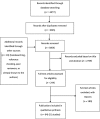Systematic review on the prevalence, frequency and comparative value of adverse events data in social media
- PMID: 26271492
- PMCID: PMC4594731
- DOI: 10.1111/bcp.12746
Systematic review on the prevalence, frequency and comparative value of adverse events data in social media
Abstract
Aim: The aim of this review was to summarize the prevalence, frequency and comparative value of information on the adverse events of healthcare interventions from user comments and videos in social media.
Methods: A systematic review of assessments of the prevalence or type of information on adverse events in social media was undertaken. Sixteen databases and two internet search engines were searched in addition to handsearching, reference checking and contacting experts. The results were sifted independently by two researchers. Data extraction and quality assessment were carried out by one researcher and checked by a second. The quality assessment tool was devised in-house and a narrative synthesis of the results followed.
Results: From 3064 records, 51 studies met the inclusion criteria. The studies assessed over 174 social media sites with discussion forums (71%) being the most popular. The overall prevalence of adverse events reports in social media varied from 0.2% to 8% of posts. Twenty-nine studies compared the results from searching social media with using other data sources to identify adverse events. There was general agreement that a higher frequency of adverse events was found in social media and that this was particularly true for 'symptom' related and 'mild' adverse events. Those adverse events that were under-represented in social media were laboratory-based and serious adverse events.
Conclusions: Reports of adverse events are identifiable within social media. However, there is considerable heterogeneity in the frequency and type of events reported, and the reliability or validity of the data has not been thoroughly evaluated.
Keywords: adverse drug reactions; adverse effects; adverse events; pharmacovigilance; social media; systematic review.
© 2015 The British Pharmacological Society.
Figures
References
-
- Fox S. The social life of health information Washington: PewResearchCenter Internet, Science & Tech; 2011 [cited 2015 1 May]. Available from: http://www.pewinternet.org/2011/05/12/the-social-life-of-health-informat...
-
- Aramaki E, Maskawa S, Morita M. Twitter catches the flu: Detecting influenza epidemics using Twitter. Proceedings of the 2011 Conference on Empirical Methods in Natural Language Processing; 1568–1576.
-
- Carneiro HA, Mylonakis E. Google trends: A web-based tool for real-time surveillance of disease outbreaks. Clin Infect Dis. 2009;49:1557–64. - PubMed
Publication types
MeSH terms
Grants and funding
LinkOut - more resources
Full Text Sources
Other Literature Sources
Medical
Miscellaneous



